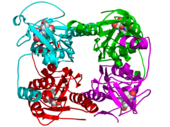Ureaplasma
| Ureaplasma | ||||||||||||
|---|---|---|---|---|---|---|---|---|---|---|---|---|
| Systematics | ||||||||||||
|
||||||||||||
| Scientific name | ||||||||||||
| Ureaplasma | ||||||||||||
| Shepard , Lunceford , Ford , Purcell , Taylor-Robinson , Razin & Black , 1974 |

Ureaplasmas , also Ureaplasma (from Latin urea "urea" and ancient Greek πλάσμα plásma "the formed"), are a genus of very small, independently reproducible bacteria from the class of the Mollicutes (from Latin mollis "soft" and cutis "skin", " the soft-skinned "). Unlike most bacteria, they lack a cell wall . They live aerobically to facultatively anaerobically and are of diverse (pleomorphic), variable, vesicular shape.
Ureaplasma are parasitic , intra- and extracellular living bacteria that are associated with numerous diseases in humans and animals. The important ureaplasmas occurring in humans are summarized in the type Ureaplasma urealyticum . Ureaplasmas are characterized by their property of lysis (dt .: cleavage, from Greek λύσις , lýsis , “solution, dissolution”) of urea (lat. Urea) and differentiated from the mycoplasma .
With a size of 580 to 1380 kbp , the genera Mycoplasma and Ureaplasma have the smallest genome of the prokaryotes capable of auto- replication with the exception of the deep-sea archaeon " Nanoarchaeum equitans " (~ 500 kbp). Their DNA genome usually has a relatively low guanine - cytosine (GC) content and their cell membrane contains cholesterol, which is otherwise only found in eukaryotes .
Classification
Scientifically speaking, the class of Mollicutes includes the six eubacterial genera Acholeplasma , Anaeroplasma , Asteroleplasma , Mycoplasma , Spiroplasma and Ureaplasma .
The phylogenetic relationship of these genera was determined by analyzing the 5S and 16S rRNA, which goes back to Carl Woese . A common feature of the mollicutes (soft skin) and thus also of the ureaplasma is the lack of a cell wall and the associated susceptibility to osmotic fluctuations in the surrounding medium. Antibiotics that attach to the cell wall (e.g. penicillins ) are practically ineffective against them. Due to the small size of ureaplasma, unlike other bacteria, they cannot be retained by sterile filters with a nominal pore size of 0.22 µm. Molecular-phylogenetic rRNA investigations showed that the mollicutes are not at the base of the bacterial phylogenetic tree, but rather emerged through degenerative evolution from Gram-positive bacteria of the Lactobacillus group with a low GC content of the DNA . In the course of this degenerative evolution the Mollicutes have lost a considerable part of their genetic information, so that today they are among the living things with the smallest known genome (Mollicutes: 580–2,300 kbp, E. coli : 4,500 kbp, Arabidopsis thaliana : 100,000 kbp, Homo sapiens : 3,400,000 kbp). Bacteria of the class Mollicutes do not live as free bacteria, but are either dependent on a host cell or a host organism.
As parasites or commensals , they receive essential metabolic components from the host organism, such as B. fatty acids , amino acids and precursors of nucleic acids . The possibility of downsizing the genome is attributed to the parasitic way of life of the Mollicutes. For the growth of some representatives of the Mollicutes, cholesterol is also required, a component that is normally not found in bacteria and whose synthesis precursors are also provided by the host cells.
Clinical significance
As parasitic bacteria, ureaplasma are the cause of numerous diseases in humans and animals. As a rule, however, bacteria from the class of the Mollicutes do not kill their host. Rather, they cause chronic infections, which speaks for a good adaptation to the hosts, and thus embody a very successful type of parasitism.
Since ureaplasmas do not have a cell wall, they can only be grown on special nutrient media or detected using the polymerase chain reaction (PCR). Ureaplasma mostly colonize the genitourinary tract and are transmitted through droplet infection and direct contact. Diseases caused by Ureaplasma urealyticum and Ureaplasma hominis are treated with the help of erythromycin , clarithromycin or azithromycin and tetracycline (such as doxycycline ).
Human medicine
- Ureaplasma urealyticum colonizes the lower female genital tract and is often transmitted from mother to child during pregnancy, where a. can occasionally be the cause of pneumonia or central nervous system infections. Whether U. urealyticum is also a causative agent of "non-gonococcal urethritis" is controversial. In men, U. urealyticum is the causative agent of non-gonorrheic urethritis and prostatitis .
- Ureaplasma hominis and Ureaplasma urealyticum are often found together in the urogenital tract. They are not the cause of their own clinical pictures, but are mostly involved in different diseases. U. hominis reproduces relatively quickly, U. urealyticum rather slowly and uses urea splitting as an energy source. Both types are facultative pathogenic and after septicemia , increasing antibody titers can be detected in the blood.
literature
- Marianne Abele-Horn: Antimicrobial Therapy. Decision support for the treatment and prophylaxis of infectious diseases. With the collaboration of Werner Heinz, Hartwig Klinker, Johann Schurz and August Stich, 2nd, revised and expanded edition. Peter Wiehl, Marburg 2009, ISBN 978-3-927219-14-4 , p. 219 f.
- Henning (ed.) Brandis with collabor. by R. Ansorg Brandis: Textbook of medical microbiology: 192 tables , 7th, completely revised. Edition, G. Fischer, Stuttgart [u. a.] 1994, ISBN 3-437-00743-2 , pp. 66, 172, 610ff.
- Shmuel Razin, Joseph G. Tully (Eds.): Molecular and Diagnostic Procedures in Mycoplasmology. Vol. 1: Molecular Characterization. Academic Press, San Diego, CA / London 1995. ISBN 0-12-583805-0 (English).
Individual evidence
- ↑ a b Henning (ed.) Brandis with collaborators. by R. Ansorg Brandis: Textbook of medical microbiology: 192 tables , 7th, completely revised. Edition, G. Fischer, Stuttgart [u. a.] 1994, ISBN 3-437-00743-2 , pp. 66, 172, 610ff.